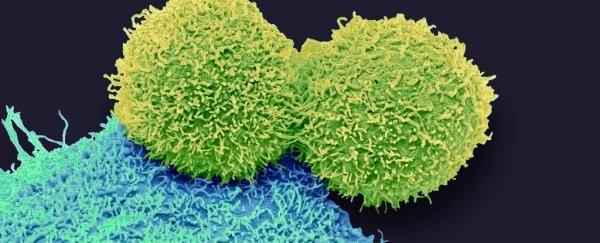An unusual but ubiquitous hormone called prolactin, which plays a vital role in producing milk during pregnancy, could also be a major driver of breast cancer, two new studies have shown.
The findings are the latest in a long line of research from a lab led by cancer pathologist Charles Clevenger from Virginia Commonwealth University, who has been trying to untangle prolactin’s precise role in breast cancer ever since he discovered the first evidence that the growth factor could be involved in the disease midway through the 1990s.
The first of these two new studies from Clevenger and co. demonstrates that the presence of certain prolactin receptors transforms abnormal breast cells into cancerous cells.
The second paper outlines how blocking cell signaling pathways activated by prolactin can also stop breast cancer cells from growing. This can be done with a drug that is currently being tested in early-stage clinical trials for multiple myeloma and non-small lung cancer.
Together, the research could help other scientists to develop new therapies for breast cancer that are designed to target specific versions of the prolactin receptor – therapies which years from now, could be used to treat different subtypes of the disease.
“Not only do most mammary [breast] tissues make their own prolactin, but so do most breast cancers,” Clevenger said in 1998, when he published work showing that more than 95 percent of all breast cancers expressed prolactin and its receptor.
However, it’s been a long and bumpy road for prolactin, which is secreted by the bean-shaped pituitary gland at the base of the brain, and was first named for its role in stimulating breast milk production.
These days, prolactin has an unrivaled number of biological functions to its name, over 300 and counting – from the ups and downs of metabolism, to helping regulate the immune system. It’s also been linked to migraines and is thought to curb grief.
However, the role of prolactin and its receptor in breast cancer has been less clear, and overlooked for decades, possibly because there are a few different forms of the prolactin receptor, each with seemingly unique functions in pregnancy and disease that researchers are still trying to tease out.
Early efforts to understand prolactin’s role in breast cancer were also undone by a slew of clinical trials in the 1980s, which failed to show any benefit of drugs targeting prolactin secretion for people with breast cancer. After this, researchers tended to focus on its role in stimulating breast tissue growth and milk production.
“This [new] research challenges the dogma that prolactin only functions in milk production and highlights the unique discovery that the hormone can contribute to breast cancer,” Clevenger said about the two new studies.
“By understanding how the prolactin receptor correlates to breast cancer, novel therapeutic and prognostic agents can be developed to effectively treat the disease.”
First up, the research team identified a modified version of the prolactin receptor (dubbed hPRLrl) and showed it was capable of turning benign breast cells with no potential to spread around the body into cancerous ones that do – but only when co-expressed and interacting with another kind prolactin receptor.
Removing the hPRLrl receptor from lab-grown breast cancer cells also reduced the cells’ malignant potential.
Next, to validate these cell-based experiments, the researchers dug into data from The Cancer Genome Atlas, a global database of tumor samples and genomic profiles.
Here they found that higher levels of the hPRLrl receptor in tumor tissues (relative to its fully-formed counterpart) were associated with more aggressive breast cancers, namely triple-negative breast cancer, which has fewer treatment options and typically, worse outcomes for those diagnosed.
But there is some good news. In a second study, the researchers showed – using multiple breast cancer models, including genetically engineered mice and patient-donated cells – how breast cancer progression could be halted using an HDAC6 inhibitor, a drug that blocks a protein associated with prolactin.
“Global analysis of gene expression again revealed that prolactin is closely associated with breast cancer growth and could be subdued by treatment with an HDAC6 inhibitor,” Clevenger said.
While this ongoing research has provided some fresh insights, and added some extra evidence for prolactin’s part in breast cancer progression, it really goes to show how the more scientists discover about cancer, the more complicated it becomes – remembering that it’s taken over 25 years to reach this new level of understanding about prolactin.
“This study adds to the already known and complex relationships between the hormone signaling pathways of prolactin, estrogen, and progesterone in breast cancer,” the research team explain in their paper.
The papers were published in npj Breast Cancer and Endocrinology.



